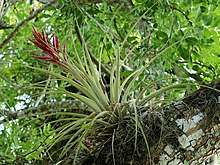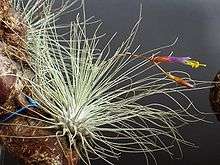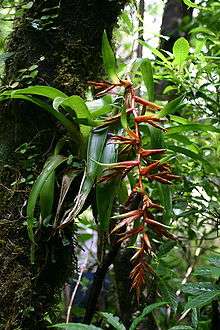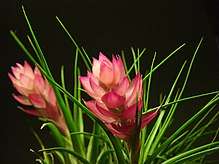Tillandsia
Tillandsia is a genus of around 650 species of evergreen, perennial flowering plants in the family Bromeliaceae, native to the forests, mountains and deserts of northern Mexico and south-eastern United States, Mesoamerica and the Caribbean to mid Argentina. Their leaves, more or less silvery in color, are covered with specialized cells (trichomes) capable of rapidly absorbing water that gathers on them.[2]
| Tillandsia | |
|---|---|
 | |
| Tillandsia fasciculata | |
| Scientific classification | |
| Kingdom: | Plantae |
| Clade: | Tracheophytes |
| Clade: | Angiosperms |
| Clade: | Monocots |
| Clade: | Commelinids |
| Order: | Poales |
| Family: | Bromeliaceae |
| Subfamily: | Tillandsioideae |
| Genus: | Tillandsia L. |
| Species | |
| Synonyms[1] | |
| |
They are also commonly known as airplants because of their natural propensity to cling wherever conditions permit: telephone wires, tree branches, barks, bare rocks, etc. Their light seeds and a silky parachute facilitate this spread.[3] Most Tillandsia species are epiphytes – which translates to 'upon a plant'.[4] Some are aerophytes, which have a minimal root system and grow on shifting desert soil. Due to their epiphytic way of life these plants will not grow in soil, but live on the branches of trees, in deserts and on other substrates that will not be saturated with water for very long.[5]
Description
They are perennial herbaceous plants which exhibit a multitude of physiological and morphological differences making this genus an excellent example of diversity. Having native habitats that vary from being epiphytic and saxicolous, species have certain adaptations, such as root systems designed to anchor to other plants or substrates, and modified trichomes for water and nutrient intake. Some of the species, like the majority of bromeliaceae, grow as funnel bromeliads, with a compressed stem axis. The leaves are then close together in rosettes, and cover the lower areas of the leaves, forming a funnel for collecting water.[6]
These leaf rosettes, a common physical characteristic in Tillandsia species, collect nutrients and water. The flowers typically involve bright, vibrant colors, with blooms or inflorescences produced on a stalk or several stalks.[7] The flower's color varies greatly; red, yellow, purple and pink flowers exist in this genus, and multicolored flowers are known. The bright colors attract pollinators. An air plant's foliage may also change color when it blooms, also attracting pollinators. The hermaphrodite flowers are threefold with double perianth. The three free sepals are symmetrical and pointed. The seeds have a "parachute" similar to the dandelion.[8]
Common pollinators of this genera include moths, hummingbirds and, more recently recognized, bats.[9]
Range
They have naturally been established in diverse environments such as equatorial tropical rain forests, high elevation Andes mountains, rock dwelling (saxicolous) regions, and Louisiana swamps, such as Spanish moss (T. usneoides), a species that grows atop tree limbs. But there are also species that live lithophytic, so on rocks (but also roofs and even telephone wires).
The green species with their claim to a cool-humid climate live mostly more in the shade terrestrial or in the lower levels of the forests.[10] In contrast, almost all gray species live in precipitation-poor areas with high humidity. They prefer the full sun and can therefore be found in the upper floors of the woods, on rocks or (rarely) on the ground. Many of the gray species are epiphytes. Some species are more or less xeromorphic.[11]
Cultivation

Tillandsias, like other bromeliads, can multiply through pollination and seed formation. Since Tillandsia are not self-fertile, the pollen must come from another plant of the same species. Tillandsia, depending on the species, may take months or years to flower. After flowering, the plant forms offsets and dies. [12]
Generally, the thinner-leafed varieties grow in rainy areas and the thick-leafed varieties in areas more subject to drought. Most species absorb moisture and nutrients through the leaves from rain, dew, dust, decaying leaves and insect matter, aided by structures called trichomes.[13] Air plants are growing rapidly in popularity as a low maintenance household plant. Due to their minimal root system and other adaptations, they generally do not require frequent watering, no more than four times a week, allowing the plant to completely dry before watering again.[14]
The amount of light required depends on the species; overall, air plants with silver dusting and stiff foliage will require more sunlight than air plants with softer foliage. They generally need a strong light. In summer outside, however, they prefer the light shade of a tree at the hottest hours. Plants are commonly seen mounted, placed in a terrarium, or simply placed in seashells as decorative pieces.[15] For so-called "aerial" species (the majority of the common species in culture except Tillandsia cyanea), that is to say those whose roots are transformed into crampons without any power of absorption, watering is done by the leaves in the form of frequent sprays, or brief soaking of the plant in a container full of water.[16] It is imperative to use non-calcareous water. Rainwater recovered from the flow of a mossy or green roof is best for this purpose, if available.[17]
Ecology
Species of Tillandsia photosynthesize through a process called CAM cycle, where they close their stomata during the day to prevent water loss and open them at night to fix carbon dioxide and release oxygen.[18] This allows them to preserve water, necessary because they are epiphytes. They do not have a functional root system and instead absorb water in small amounts through their leaves via small structures called trichomes. Species of Tillandsia also absorb their nutrients from debris and dust in the air.[19]
Any root system found on Tillandsia has grown to act as a fragile stabilizing scaffold to grip the surface they grow on. As soon as they have been soaked with water, the green assimilation tissue below the suction scales becomes visible again, the plant is therefore "greened". Now the plant can absorb more light. When the sun dries the plants, they turn white. Thanks to this special survival trick, plants without roots can absorb fog droplets as well as rainwater and thus cover their water needs.[20]
Temperature is not critical, the range being from 10 °C (50 °F) to 32 °C (90 °F). Frost hardiness depends on the species. T. usneoides, for example, can tolerate night-time frosts down to about −10 °C (14 °F). For most species, the ideal growth temperature is between 20 °C and 25 °C, with a minimum of 10 °C and a maximum of 30 °C. Few are resistant to −10 °C, but some, usually from higher elevation areas, are hardy enough to withstand light and brief freezes and live outdoors year round in areas with mild winters.[21]
Taxonomy
The genus Tillandsia was named by Carl Linnaeus after the Swedish physician and botanist Dr. Elias Tillandz (originally Tillander) (1640–1693). Some common types of Tillandsia include ball moss (T. recurvata) and Spanish moss (T. usneoides). The genus contains around 650 species, where 635 are considered epiphytic[22] are traditionally divided into seven subgenera:[23]
- Tillandsia subg. Allardtia (A. Dietr) Baker
- Tillandsia subg. Anoplophytum (Beer) Baker
- Tillandsia subg. Diaphoranthema (Beer) Baker
- Tillandsia subg. Phytarrhiza (Vis.) Baker
- Tillandsia subg. Pseudalcantarea Mez
- Tillandsia subg. Pseudo-Catopsis Baker
- Tillandsia subg. Tillandsia
Four species are protected under CITES II:[24]
Gallery
- Tillandsia recurvata and another Bromeliaceae species on electric wires near San Juan de los Morros, Venezuela
.jpg) Tillandsia ionantha with bright-coloured foliage during full bloom. Some foliage has a light, silver dusting which can be easily scratched off.
Tillandsia ionantha with bright-coloured foliage during full bloom. Some foliage has a light, silver dusting which can be easily scratched off. Seeds of Tillandsia schiedeana – MHNT
Seeds of Tillandsia schiedeana – MHNT Tillandsia ionantha in bloom.
Tillandsia ionantha in bloom.

 Tillandsia excelsa, a green funnel bromeliad with green leaves and hanging inflorescence at the site
Tillandsia excelsa, a green funnel bromeliad with green leaves and hanging inflorescence at the site Tillandsia. 2018 Taichung World Flora Exposition, Taiwan.
Tillandsia. 2018 Taichung World Flora Exposition, Taiwan. Tillandsia. 2018 Taichung World Flora Exposition, Taiwan.
Tillandsia. 2018 Taichung World Flora Exposition, Taiwan. Tillandsia. 2018 Taichung World Flora Exposition, Taiwan.
Tillandsia. 2018 Taichung World Flora Exposition, Taiwan. Tillandsia. 2018 Taichung World Flora Exposition, Taiwan.
Tillandsia. 2018 Taichung World Flora Exposition, Taiwan. Tillandsia regnellii brazil
Tillandsia regnellii brazil
References
- "World Checklist of Selected Plant Families".
- Mendoza, C., Granados-Aguilar, X., Donadío, S., Salazar, G., Flores-Cruz, M., Hágsater, E., Starr, J., Ibarra-Manríquez, G., Fragoso-Martínez, I., Magallón, S. March 2017. Geographic structure in two highly diverse lineages of Tillandsia (Bromeliaceae).
- "Tillandsia". Natural Resources Conservation Service PLANTS Database. USDA. Retrieved 10 December 2015.
- Benzing, D. 2012. Air Plants: Epiphytes and Aerial Gardens. Ithaca: Comstock Publishing Associates.
- Galán de Mera, A., M. A. Hagen & J. A. Vicente Orellana (1999) Aerophyte, a New Life Form in Raunkiaer's Classification? Journal of Vegetation Science 10 (1): 65–68
- Mendoza, C., Granados-Aguilar, X., Donadío, S., Salazar, G., Flores-Cruz, M., Hágsater, E., Starr, J., Ibarra-Manríquez, G., Fragoso-Martínez, I., Magallón, S. March 2017. Geographic structure in two highly diverse lineages of Tillandsia (Bromeliaceae).
- Steens Andrew (2003); Bromeliads for the contemporary garden , Timber Press, Portland, USA. (ISBN 0-88192-604-3)
- Lyman B. Smith , RJ Downs: Tillandsioideae (Bromeliaceae). In: Flora Neotropica , vol. 14, 2, 1979, p. 665.
- Aguilar-Rodríguez, P., Macswiney, C., Krömer, T., García-Franco, J., Knauer, A., Kessler, M. March 2014. First record of bat-pollination in the species-rich genus Tillandsia (Bromeliaceae). Annals of Botany. Vol. 113(6) pp. 1047–1055.
- Rauh Werner (1970 vol.1, 1973, vol.2); Bromelien , Verlag Eugen Ulmer, Stuttgart. / Bromeliads (English translation, 1979), Blandford Press. ( ISBN 0-7137-0845-X )
- Elvira Groß : Beautiful Tillandsien. Ulmer, Stuttgart 1992, ISBN 3-8001-6501-5
- Elvira Groß : Tillandsia for room and conservatory. Ulmer, Stuttgart 2001, ISBN 3-8001-3222-2
- Steens Andrew (2007); Bromeliads connoisseur's guide , Random House, London. ( ISBN 978-1-86962-127-8 )
- Wolfgang Kawollek: Tillandsien – species and culture. Publisher Naturbuch Verlag © 1992 Weltbildverlag GmbH Augsburg ISBN 3-89440-038-2
- Cuzenic Stephan & Lévêque Daniel (2005); Tillandsias and other Bromeliads , Eugen Ulmer, Paris. (ISBN 2-84138-245-1)
- Hayland, Lindsey (31 May 2019). "How To Water Air Plants The Right Way To Keep Your Air Plant Alive". Urban Organic Yield.
- Instructions: Care for Air Plants (Tillandsia). Wedgewood Gardens. Available from: http://www.wedgewoodgardens.com/Care_Sheet_-_Air_Plants.pdf
- David H. Benzing (2008). Vascular Epiphytes: General Biology and Related Biota. Cambridge University Press. p. 53. ISBN 9780521048958.
- Benzing, David H.; Burt, Kathleen M. (1970). "Foliar Permeability Among Twenty Species of the Bromeliaceae". Bulletin of the Torrey Botanical Club. 97 (5): 269–279. doi:10.2307/2483646. JSTOR 2483646.
- Klaus Labude: Tillandsien. Tetra publishing house, Bissendorf Wulften, 2002, ISBN 3-89745-155-7
- Benzing, David H.; Dahle, Christopher E. (1971). "The Vegetative Morphology, Habitat Preference and Water Balance Mechanisms of the Bromeliad Tillandsia ionantha Planch". The American Midland Naturalist. 85 (1): 11–21. doi:10.2307/2423907. JSTOR 2423907.
- Mendoza, C., Granados-Aguilar, X., Donadío, S., Salazar, G., Flores-Cruz, M., Hágsater, E., Starr, J., Ibarra-Manríquez, G., Fragoso-Martínez, I., Magallón, S. March 2017. Geographic structure in two highly diverse lineages of Tillandsia (Bromeliaceae).
- Tania Chew, Efraín De Luna & Dolores González (2010). "Phylogenetic relationships of the pseudobulbous Tillandsia species (Bromeliaceae) inferred from cladistic analyses of ITS 2, 5.8S ribosomal RNA gene, and ETS sequences" (PDF). Systematic Botany. 35 (1): 86–95. doi:10.1600/036364410790862632. Archived from the original on March 23, 2015.CS1 maint: unfit url (link)
- "Appendices I, II and III valid from 5 February 2015*". CITES. Retrieved 23 February 2015.
External links

